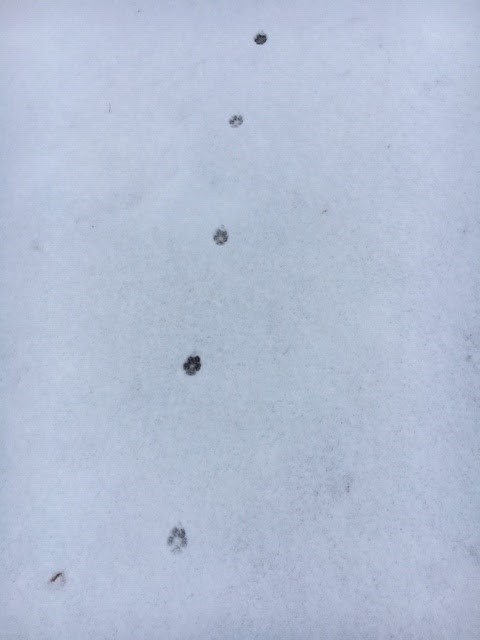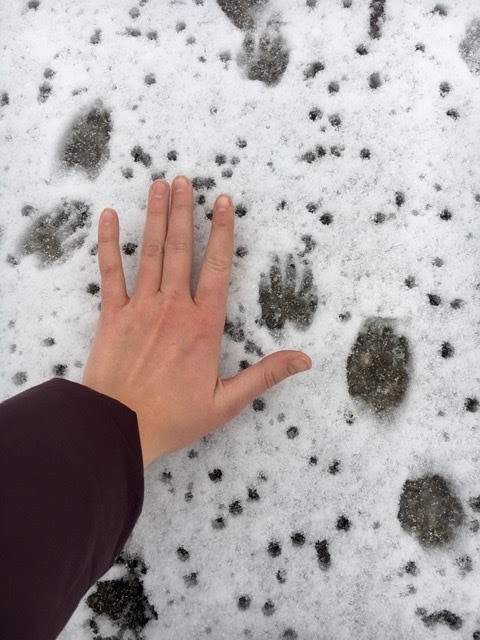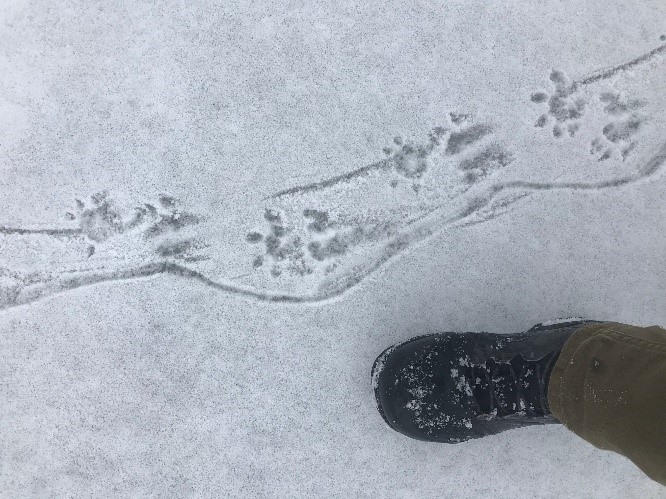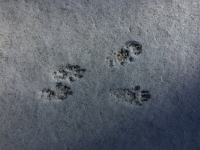The best time to spot fresh tracks is in the early morning after a fresh snowfall, before the snow has been walked on too much covering the tracks. At this time, you’re more likely to see the trails of nocturnal animals like red foxes, raccoons, and opossums, while also catching the tracks of early risers like squirrels, deer, and rabbits. The rising sun will also cast shadows that make the tracks easier to spot in the white snow. If you and your family aren’t early birds, shadows cast as the sun begins to set will also highlight tracks if you want to take an after-dinner trip outside instead. You can tell a lot about an animal from looking at its tracks!

Fox tracks (photo by Brynne Drohan)
What clues can I look for? If you can, try to count the number of toes imprinted. If you count four toes on each of the front and hind feet, it could be a fox, coyote, or neighborhood dog or cat. Four toes on each foot are shown in the photo of fox tracks above! If you count four toes on the front feet but five toes on the hind feet, it might be a rodent such as a mouse, chipmunk, or squirrel. For tracks that have five toes each on the front and hind feet, an animal such as a raccoon, skunk, or opossum may have been wandering around. We can see five toes on each foot in the photos of raccoon and opossum prints below! If you find a two-toe track around Milwaukee, it’s almost certainly from a deer.

Raccoon tracks (photo by Brynne Drohan)
How big is it? The bigger the print, the larger the animal! You can use your ruler to measure the size of the print, or you can just eyeball it. You can also measure the distance between each footprint to estimate the stride, which is another clue in determining the overall size. If you don’t have a ruler handy, compare the size of the track with the size of your hand (you can measure your hand later). Or better yet, take a picture of the track next to your hand and post it on iNaturalist and the community will help you identify it!
Where was it going? You can usually tell which direction an animal was traveling by the placement of the toes. If you can’t make that out, look for a “skid” - when an animal steps forward in heavy snow, the paws might drag a little just behind the print, leaving a skid. You can also look for different patterns left by different animals. For example, as seen in the photo of the fox tracks, a fox often “registers” where it puts its hind foot directly where its front foot was. This method of walking in their own footprint saves them crucial energy, especially in deep snow. Animals with tails may leave lines in the snow, like we see with the opossum tracks below.

Opossum tracks (photo by Michaela Rosenthal)
You can now follow the tracks in the direction the animal was going. If the tracks lead to a tree, look up to see if you can find a nesting cavity or a squirrel’s nest! Look for rabbits under spruce trees! You’re likely to see dog tracks all over the sidewalks! Use your imagination to try to figure out what the animal was doing and take a look at the Milwaukee wildlife!
Written by Communications Intern Ellie Rickman.
Sources:
https://www.youtube.com/watch?v=PnF6UZ8VGss&feature=youtu.be
https://www.caveofthemounds.com/2020/06/18/winter-family-fun-in-wisconsin-animal-tracks-in-the-snow/
https://www.almanac.com/content/animal-track-identification#





